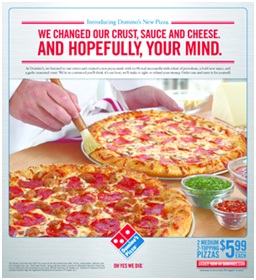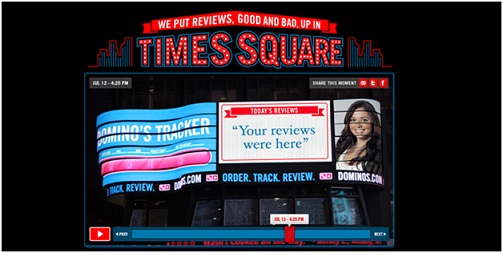Being Flawsome - Ensuring Brand Loyalty
How many times have we watched an advertisement and scorned at its far-fetched claims? How often has a certain ShahRukh Khan induced us into believing how using “Nav Ratna Tel“ brought success in his life? How often have we laughed at the lady who uses her long, strong hair to pull a truck, attributing the feat to the usage of Garnier Shampoo?

Gone are the days when the customers were naïve and fell prey to the myriad marketing gimmicks of companies. In today’s generation, information is just a click away and customers are a lot more aware and cautious about what they choose to believe. Information is no longer one-sided. Brands cannot keep on harping about the out-of-the-world benefits that their products provide and expect customers to take it all lying down. These days customers utilize the forum provided by the social networks, blogs etc to express their opinion freely and do not hesitate to criticize what they find irrational. In this changed environment should the advertisers continue to showcase their products as perfect and flawless?

It has been observed that people have a hard time “genuinely connecting “ with , being close to,or really trusting other humans who (pretend to) have no weaknesses, flaws, or mistakes. The same applies to how humans connect with brands. They are becoming increasingly skeptical about the “perfection” that a brand associates with its products. They are more comfortable accepting that a brand has minor flaws. Despite the flaws, they embrace it wholeheartedly. After all, to err is human, and brands are nothing but representations of human values.
So this brings forth the question: How should one showcase one’s products? The best way to promote one’s products is by bringing forth the reality. And who knows the reality better than the people who use our products? Yes, the answer lies in letting the customers do the talking. Pure, unfiltered feedback from the customers, be it positive or negative, can always help instill faith in the customer’s mind about the value created by our products. Transparency is the key word here. Brands that do not hide their flaws and still thrive in the market are said to be “Flawsome”.
These brands encompass within themselves the human values of humility, empathy, flexibility and maturity. Such brands have the distinct advantage of having earned their customers’ trust which, by all means, is the best ingredient for ensuring brand loyalty. The key to success here is to not only accept the flaws but also undertake steps to minimize, if not eliminate, these flaws. Such an approach adopted by the brand reflects its openness towards criticism and underlines the importance it places in the feedback of the customer.
Now the question is: How do we implement this strategy? Companies can include all comments, likes, and reviews on social networking sites and blogs on their website. This will enable the prospective buyers to gain insights about the experiences of existing users and will also provide a forum for existing users to express their satisfaction or dissatisfaction with the product. This gives the customers the freedom to evaluate the brand and express themselves freely, unlike the traditional method of mass advertising, wherein the “perfection” of the brand was pushed down the throat of the customers. It also helps the brand to indulge in active engagement with its customer base.
According to a study , 68% of consumers trust reviews more when they see both good and bad scores, while 30% suspect censorship or faked reviews if there aren’t any negative comments or reviews (Source: Reevoo.com, January 2012). It has become clear that people really do not believe that a product can ever be perfect, and products that insist on projecting the image of flawlessness are met with cynicism and disbelief. Consumers seem to value the honesty and openness more than they do the contrived illusion of perfection. The mantra is to address the problems underlined in the negative reviews and turn even criticism to one’s advantage.

|
Figure 2: Domino’s Pizza Turnaround Campaign |
Numerable examples can be cited wherein brands have openly accepted their flaws and celebrated customer dislike, which as a result of being handled well, ultimately contributed positively to the brand image. One such company is Domino’s Pizza which faced a major crisis when two of its employees posted some improper videos about the company on Youtube. These videos gained immense popularity and within a day got around 200000 views. The company’s image was at stake and this incident prompted an apology video on YouTube by company CEO Patrick Doyle. Eight months later the company launched a new campaign entitled “Pizza Turnaround”. As a part of this campaign it released a four minute video on YouTube wherein many disgruntled customers were shown expressing their dissatisfaction with the crust (which according to them tasted like cardboard) and the ketchup- like sauce. However, instead of ignoring or letting these negative comments bring them down, the video showed how the employees faced it head on and got inspired by it to deliver a better pizza to serve its customers better.
The determination of the employees to work on the customers’ grievances and the company’s honesty in accepting the criticism and using it constructively to improve their product won the hearts of its loyal customers and critics alike. Dominos pizza reported a significant rise in profits and sales after the campaign. Post this incident, Dominos has strived to maintain transparency in all its operations. It ran an electronic Ticker on a billboard in Times Square which displayed unfiltered comments from its customers- be it good, bad or ugly -to disclose publicly what its customers think about the company. By doing this, though it ran the risk of accepting its weaknesses, it was appreciated for its honesty and its sincere attempts to bring forth the reality. The picture below shows the billboard that was put up by Dominos in Times Square.

Figure 3: Billboard showing domino's reviews
Another instance of a company which encouraged customers to dislike or post negative reviews about its product was Unilever’s Marmite,a savory yeast based spread popular in the UK. It has a distinctive, powerful flavor which is liked by some and disliked by some. This strong flavor earned the brand a lot of critics. The company reacted to this by launching its “Love It or Hate It Campaign”. Marmite runs a dual skinned website with two URLs; I Love Marmite and I Hate Marmite, where people may share their experiences of Marmite and are actively encouraged to fuel this debate.
This product was a fairly low involvement product and there were not many customers who were particularly brand loyal .However, it had its fair share of customers who were particularly averse to its strong taste. The presence of these “ haters” fuelled the emergence of “Marmite lovers” who were nothing but those customers who were not really great patrons of the brand but were those who did not mind its taste. However, this division of customers into “lovers” and “haters” and encouragement of their conflicting points of view created strong brand loyalty for the existing customers who had transgressed into being a “lover” of the brand.
This campaign was so effective that it gave rise to a phrase namely “Marmite Effect” that describes any situation that provokes strong and polarized feelings and reactions.
The figure below is a snapshot of the website of the company.

Figure 4: Marmite's website showcasing the love and hate campaign
The "Love it or Hate It" campaign brought to an end five years of stagnating sales and a weakening brand and led to sustained, penetration-led growth of around 5% each year for the next five years. The campaign induced passion among the people, positive or negative notwithstanding, and fuelled customer engagement. Social media was a major reason for the success of this campaign. Today the brand has a fully fledged social media presence with over 500,000 people liking the brand and 182,000 liking The Marmite Hate Party.
Hence, in light of the discussions above, the steps that should be taken by a company to handle this new set of customers who are more aware, have better access to information and who do not hesitate to voice their opinions publicly are :
- Crowdsource feedback and suggestions: This allows the customers to express themselves freely and results in higher customer engagement.
- Incorporating transparency into marketing communications and events:This helps in clinching the customers’ trust.
- Acknowledge a disconnect-You Either take us or Leave Us: This helps in infusing increased brand loyalty among existing customers and growing engagement among brand patrons and haters alike.
- Highlight the problem faced and showcase the steps being taken to eliminate it: This underlines the importance given to customer feedback and thus deepens its connect with them.
Hence we see that criticism is not always a bad thing. As quoted by poet John Lydgate and later adapted by President Lincoln - “You can please some of the people all of the time, you can please all of the people some of the time, but you can’t please all of the people all of the time”. It is not possible for brands to cater to the needs of all the customers. Hence every brand will have its own set of loyalists as well as critics. However, a successful brand is one that doesn’t get daunted by these criticisms but turns it around in such a way that it helps in fuelling its brand image positively.
It can be observed that most of the companies embracing the “Flawsome” strategy are foreign based. It still remains to be seen how effectively it can be exploited by marketers in India. This strategy can be expected to lead to far reaching effects and revolutionize the way products are advertised presently- After all, Nobody is Perfect!
This article has been authored by Isha Pandey from TAPMI.
Image(s): FreeDigitalPhotos.net
Views expressed in the article are personal. The articles are for educational & academic purpose only, and have been uploaded by the MBA Skool Team.
If you are interested in writing articles for us, Submit Here
Share this Page on:
What is MBA Skool?About Us
MBA Skool is a Knowledge Resource for Management Students, Aspirants & Professionals.
Business Courses
Quizzes & Skills
Quizzes test your expertise in business and Skill tests evaluate your management traits
All Business Sections
Write for Us